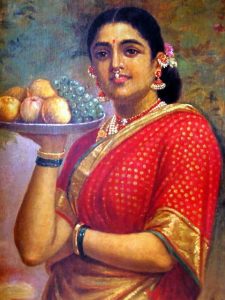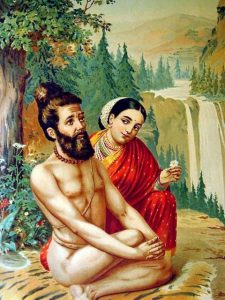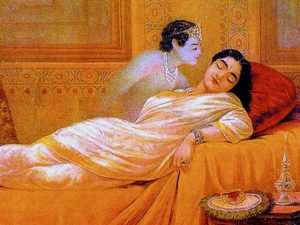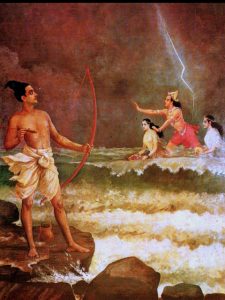





RAJA RAVI VARMA 2/4 – He was born in Kilimanoor (a small town of Kerala). His inborn talent, started showing at a very tender age. His parents sent him to study under patronage, when he was 14 years old, receiving tutelage from Rama Swamy Naidu and Theodor Jenson. He is known for his amazing paintings, which revolve mainly around the great epics of Mahabharata and Ramayana. His representations of Hindu gods and goddesses (and characters in the epics and the Puranas), reflected his absorption in Indian culture.

RAJA RAVI VARMA 3/4 – He often modelled Hindu Goddesses on South Indian women, whom he considered beautiful. His paintings of beautiful sari clad women, have also received recognition in the west. His paintings can be classified into three categories: portraits, portrait-based compositions and theatrical compositions based on myths and legends. He also received international recognition in 1873, when he won the first prize for his paintings at the Vienna Art Exhibition. When India was looking for inspiration to free itself from British rule, his oil paintings of India’s past became highly popular.

RAJA RAVI VARMA 4/4 – He had travelled throughout India in search of subjects. His popularity soared so high that his paintings were sent to World’s Columbian Exposition held in Chicago in 1893. In 1894, with the aim to bring Indians closer to art, he started a lithography printing press (called the Ravi Varma Pictures Depot) for mass production of his paintings. His press was the largest and most innovative press in India at that time. A crater on Mercury, was named in the honor of this greater Indian painter.
To pursue this issue, you can also read:
http://meetingbenches.com/2016/11/epically-painting/
When the night is more alive and colorful than the day It was "Because the…
Identity as a poem in continuous evolution Identification is never a final destination, but a…
The spark that triggers a path of introspection and inner transformation The title “ASTONISHMENT” immediately…
Reflections on waiting and the transformative winds that push you forward Minimalist poetry, with its…
If you don't know sadness, you can't have deep thoughts Depth is a multifaceted concept…
James Hamilton-Paterson: When life is a Pilgrimage His early work reflects a youthful optimism and…
This website uses cookies.